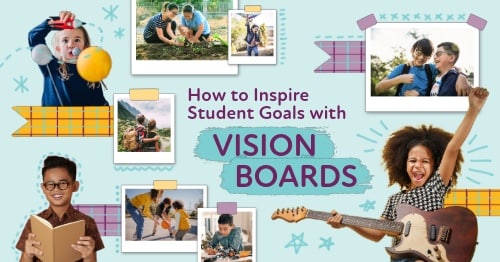How to Develop Curiosity and Student Engagement in Online School
by Valerie Kirk
byNell Gladson
5 min to readGoals are unique to every student—and can sometimes be difficult for them to imagine, let alone put into words. This is where vision boards can can serve as a creative way to help students picture ambitions and to inspire the actions needed to achieve them.
A vision board is a collection of images, quotes, words, objects, art, or doodles that represent a person’s dreams, goals, and aspirations for the future. It’s most often created on posterboard or digitally in a collage format built from curated images, text, and other materials.
Vision boards are used to help students think through what they want their futures to look like and set meaningful goals. Vision boards also serve as a way for them to visualize their definition of success and can become a personal roadmap to keep them on track.
Vision boards can benefit students by:
Making a vision board for students is a straightforward process that requires thought, time, and some basic craft supplies or image editing software. recorders, timers, and text-to-speech software.
When it comes to deciding what to put on a vision board, the sky’s the limit. As a Learning Coach, you might want to encourage your student to make a vision board that relates to their school, personal, or career goals. Or you can leave the purpose open-ended to include any dream they choose to imagine—like going to the Super Bowl or connecting more to nature.
Whether practical or aspirational, there’s no right or wrong way to vision board; just keep in mind that the project’s purpose should be to create something that inspires students to clarify and stay focused on their goals.
Follow these four simple steps for creating a vision board for students:
It can be helpful for students to see what the final product looks like, especially if they have never made one for themselves before. Many examples of vision boards and templates can be found on Pinterest through their site search.
For a vision board to have meaning, there needs to be a fair amount of student time spent thinking about goals and dreams. Ways to facilitate that include:
Prompt them with grade-appropriate questions such as, “What color makes you feel positive?” or “What is your dream job?” Have them write down the answers.
Ask them to write a journal entry about what motivates them, where they see themselves in the future, and what gives them joy.
You’ll need some basic supplies to get started on a vision board, including:

Start by letting them choose the images and objects they want to use to visualize their dreams. Then, let them create the vision board under their own direction.
The point of a vision board is to inspire action. To do that, it needs to be visible. Don’t let students stuff it in a drawer. Instead, ask them to put it in plain view to give them daily motivation.
Some good places to display a vision board include:
Seeing their vision board every day, even briefly, can help keep them focused on their goals and better remember what they are working towards.
